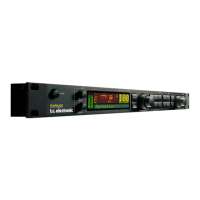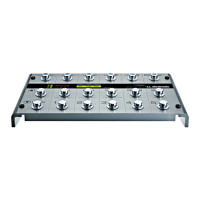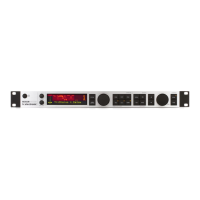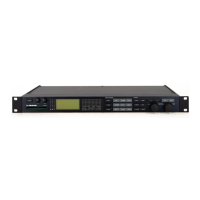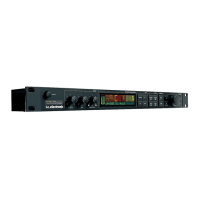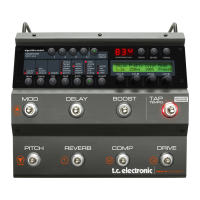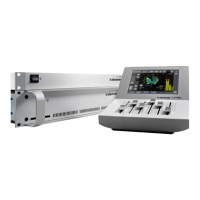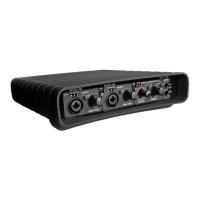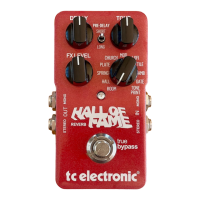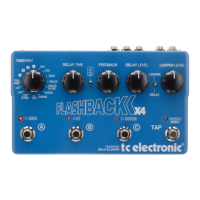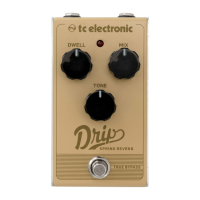How to fix no sound issue on TC Electronic Music Equipment?
- JJustin JohnsonAug 17, 2025
If there is no sound, and Killdry in the I/O setup is set to ON while the unit is bypassed, ensure that Killdry is set to OFF.
How to fix no sound issue on TC Electronic Music Equipment?
If there is no sound, and Killdry in the I/O setup is set to ON while the unit is bypassed, ensure that Killdry is set to OFF.
What to do if TC Electronic Music Equipment doesn't turn off with the power switch?
If you cannot turn off the power with the power switch, press and hold the switch for at least 1 second. This delay prevents unintended power offs.
What to do if TC Electronic Music Equipment display is blank?
If the display is blank and you cannot run the application software, enter the SOFTWARE BOOT menu by keeping the ENTER button pressed at power on. Then, dial the option to INFO and press ENTER to check the application software. If it is corrupted, reload the application software.
Why is the right input meter not showing any signal on my TC Electronic Music Equipment?
If the right input meter is not showing any signal, check if 'L-Only' is selected in the I/O Setup within the Audio menu.
How to fix lines or spots on TC Electronic Music Equipment display?
If you observe lines or spots on the display or the backlight is blinking, first ensure that no external equipment is influencing the display with magnetic or hot fields. If the distortion persists, replace the display. If the backlight is bad or blinking, inspect the soldering on the display, especially the two connections going to the upper part of the display.
What to do if I still have problems with presets made in version 1.05 after installing a new software version on my TC Electronic Music Equipment?
If you continue to experience issues with presets created in version 1.05 after a software update, recall the affected preset and save it to a new preset number. Alternatively, you can save all presets to a card and then perform a master reset, loading the presets afterward.
How to resolve 'Invalid software' message when loading software from G-Card on TC Electronic Music Equipment?
To resolve the 'Invalid software' message when loading from a G-Card: 1. Insert the G-Card. 2. Power on using the front switch. 3. When 'CARD ACCEPTED' appears, power off. 4. Quickly press ENTER while powering on again to access the boot menu. 5. Press ENTER again to load the software, which takes about 15 seconds.
What does the message 'User Preset Error, Cleared All Presets' mean on TC Electronic Music Equipment?
The message 'User Preset Error, Cleared All Presets' normally appears during the first power up after a RESET. It indicates that all presets have been set to the factory default.
What to do if analog in/out fails on TC Electronic Music Equipment?
If the analog in/out fails, try using different cables. When connecting analog in/out to unbalanced equipment, ensure that XLR pin 3 is connected to pin 1. If IC35 and IC36 are defective, replace them with type MC33079.
What to do if digital or MIDI in/out fails on TC Electronic Music Equipment?
If the digital or MIDI in/out fails, try using different cables. Note that Digitech pedals are incompatible.
Congratulates the user on purchasing the G-Force and expresses hope for their enjoyment of the product.
Explains how to use the manual, suggesting users can start without reading it or delve deeper for specific functions.
A foreword from a guitar player discussing their experience with the G-Force.
Discusses the G-Force's user-friendliness, flexibility, and potential for creative effect design.
Explains the general operation of the G-Force using parameter and value wheels and arrow keys.
Details the process of recalling presets, including scrolling through and loading them.
Describes how to quickly store a preset, either with the same name or in the first available user space.
Explains how to access the edit display for effects and modify their parameters.
Guides on connecting and configuring a MIDI board for preset control on the G-Force.
Details how to connect and set up an expression pedal to control G-Force parameters.
Explains how to adjust input and output levels using the front panel knobs and the Killdry function.
Instructions for powering the unit on and off.
Describes the function of the input and output level adjustment knobs.
Information about the PCMCIA slot for storing and loading presets.
Explains the function of the input level meters and gain reduction indicators.
Describes the Billboard display's capabilities for showing preset info, tempo, and messages.
Provides important notes regarding connections, cable types, and power supply compatibility.
Clarifies that signal is always present at outputs and mentions the 44.1kHz sample rate limit and input level optimization.
Step-by-step guide on creating user presets, including recalling factory presets and inserting effects.
Details two methods for inserting effects into a routing, using bypass keys or selecting from a menu.
Explains how to access and edit effect parameters via the edit display or routing display.
Discusses methods for setting preset levels, recommending headroom and using the In Level parameter.
Guides on adding effects blocks in parallel or series within the routing matrix.
Explains how to select different variations (sub-algorithms) for an effect, like changing a stereo delay to a dual delay.
Describes using the Layout display to reposition effect blocks within the routing matrix.
Explains how to move effect blocks using the Layout display to insert a Compressor before Delay and Reverb.
Details how to remove or substitute effect blocks within the routing by using the bypass key.
Guides on saving user presets, including storing with the same name or creating a new name using the letterbox.
Explains how to achieve effect spillover for Reverbs and Delays during preset changes.
Introduces the concept of connecting internal modifiers (LFOs, ADSRs) to create dynamic effects.
Step-by-step on setting up a ducking delay using the Envelope follower modifier.
Explains how to create an autopanning delay effect using LFO1 in the Modifier Matrix.
Covers connecting and setting up an expression pedal for various G-Force functions.
Details how to connect an expression pedal either directly or via a MIDI board.
Explains how to calibrate and select the correct pedal type in the Utility menu.
Describes how to link an expression pedal (Ext1-8) to parameters and provides an example of controlling Pitch In level.
Guides on setting up a MIDI board to control the G-Force, including basic channel and program change settings.
Explains how to use a MIDI board to change between User presets on the G-Force.
Details how to set up specific MIDI controller boards and use the Learn function for custom assignments.
Describes how to load a single effect block from one preset into another existing preset.
Introduces different setup configurations for the G-Force in various guitar rigs.
Describes a mono setup using the G-Force with a combo amp or mono stack.
Details a stereo setup leveraging the G-Force's stereo effects with multiple amps.
Explains the ultimate serial setup, utilizing the 24-bit converters for high-quality signal processing.
Describes using the G-Force in a parallel setup with a line mixer, emphasizing the Killdry function.
Provides information on connecting the G-Force using unbalanced input and balanced output jacks.
Guides on setting input and output levels for optimal signal quality and gain staging.
Explains the parameters in the Recall display: Select, Bank, and Preset.
Details the procedure for recalling a preset by scrolling and pressing Enter.
Explains how to achieve effect spillover for Reverbs and Delays during preset changes.
Provides tips for smooth preset changes while playing, suggesting routing consistency and bypassing blocks.
Guides on recalling a single effect block from one preset into an existing routing.
Instructions for saving new user presets, including selecting a location and naming the preset.
Describes the shortcut for storing presets with their existing names.
Explains the Letterbox interface for inputting custom preset names.
Details how to use PCMCIA memory cards for storing and backing up user presets.
Explains the process for deleting unwanted user presets.
Guides on accessing and editing individual effect parameters through various displays.
Explains how to select different variations or sub-algorithms for a chosen effect.
Details how to change the order or insert effect blocks within the routing matrix.
Describes how to quickly access an effect's edit display from the routing view.
Explains how to adjust the mix level and input level for individual effects within a preset.
Introduces the Layout display for visual management and rearrangement of effect blocks.
Describes functions for manipulating columns within the Layout display, such as moving and inserting.
Details functions for manipulating rows within the Layout display, such as moving and deleting.
Covers settings for analog and digital audio inputs and outputs, including source, input type, and killdry function.
Explains global MIDI settings, including basic channel, program change, and mapping options.
Allows users to create custom MIDI program change mappings for specific G-Force functions.
Details various control parameters, including setup banks, board defaults, G-Force control functions, and modifier inputs.
Explains how to set up external controllers like expression pedals and MIDI devices for parameter control.
Describes the four available setup banks for storing and recalling configurations.
Information on loading factory default settings for various supported MIDI controller boards.
Explains how G-Force parameters like Main Vol, Tempo, Bypass, and Tuner can be controlled externally.
Details how the eight external controller inputs (Ext 1-8) can be assigned to control parameters.
Explains how to externally control the bypass status of individual effect blocks.
Illustrates the flow of external and internal controller signals to parameters via the Modifier Matrix.
Provides a practical example of connecting an expression pedal to control the input level of a Delay block.
Describes how external controllers are mapped to internal parameters using the Modifier Matrix.
Explains the graphical representation of connections between modifiers and parameters.
Details how to establish and modify the relationship (curve, input/output points) between a modifier and a parameter.
Refers to the process of defining how a modifier's input affects a parameter's output.
Explains the Modifier Matrix interface for connecting internal modifiers and external controllers to parameters.
Explains how parameter values are handled when a preset with modifier connections is recalled.
Introduces the internal modifiers (Envelope, ADSR, LFO) and how to edit their parameters.
Describes the Envelope Follower modifier and its Attack/Release parameters for dynamic response.
Explains the ADSR envelope generators, their parameters (Attack, Decay, Sustain, Release), and modes.
Details the Sustain parameter for ADSR envelopes, including sustain level and duration.
Explains the Sust-Retrig mode for ADSR envelopes, allowing retriggering during the sustain phase.
Defines the input level threshold that triggers an ADSR sequence.
Describes the Low Frequency Oscillator (LFO) modifiers, their speed, depth, tempo, curve, and phase settings.
Explains how the Parameter and Value wheels can simulate external controllers for testing modifier connections.
Covers global configuration settings like display angle, parameter dial direction, and preset change behavior.
Details settings related to external controllers, including pedal type, calibration, and curve adjustments.
Instructions for backing up and restoring user presets to or from a memory card or MIDI device.
Guides on performing a MIDI bulk dump of user presets to another device.
Explains how to configure the Billboard display, including scrolling speed, activity, and custom messages.
Describes setting the global tempo by tapping or dialing, affecting all delay and speed-based algorithms.
Explains how to use tapped tempo with subdivisions for delay effects.
Details the information shown in the tempo display and how to set BPM.
Configures whether presets instantly adopt the global tempo or wait for the next tap.
Explains how to control tempo using external input jacks or MIDI switches.
Introduces the tuner display and its four setup parameters for tuning a guitar.
Explains the Tuning Note parameter, allowing auto-detection or manual note selection for tuning.
Describes the Master Tune parameter for calibrating the tuner's pitch detection.
Option to keep the Tuner display constantly visible on the Billboard.
Enables muting the output signal while the tuner is active for silent tuning.
Explains how to activate the tuner using external pedals or MIDI signals.
Introduces the chapter covering edit parameters for eight effect blocks and input/output sections.
Explains the different mute modes for effect blocks, defining their behavior when bypassed.
Details the Noise Gate block, its function, parameters (Mode, Threshold, Max. Damping, Release rate), and level control.
Explains the Compressor block, its purpose, and key parameters like Threshold, Ratio, and Knee Mode.
Introduces the Filter block and its five sub-algorithms: Parametric EQ, Wah Wah, Formant, Resonance, and Phaser.
Details the Parametric EQ, including shelving and bell filters, and parameters like Freq, Slope/BW, and Gain.
Describes the Resonance filters, their order, cutoff frequencies, and resonance amount.
Explains the Wah Wah effect, its frequency, instrument modes, and connection to modifiers.
Introduces the Formant filters, their ability to create unique vocal-like sounds, and parameters like Start, Thru, and End.
Defines the starting point of the formant curve for shaping the sound.
Explains the Phaser block, its parameters (Speed, Tempo, Depth, Order, Feedback, Mix), and instrument modes.
Controls the speed (rate) of the Phaser effect.
Sets the Phaser's speed relative to the global tempo.
Describes the Pan and Tremolo blocks, differentiating them by how their level changes affect stereo channels.
Explains the Tremolo effect, its speed control, and relationship to tempo and LFO curves.
Details the Pitch block, its Fixed and Intelligent modes, and parameters like Key, Scale, and Mode.
Allows setting the musical key for the Intelligent Pitcher to generate voices within.
Defines the scale (e.g., Ionian Major) used by the Intelligent Pitcher for voice generation.
Selects between Stepped or Smooth modes for the Intelligent Pitcher's behavior.
Sets the specific notes within the chosen scale and key that the Intelligent Pitcher will play.
Adjusts the detuning amount for the two voices, allowing for vibrato effects.
Enables users to define their own musical scales with specific notes and root keys.
Explains the Fixed Pitch mode, which applies a constant pitch shift regardless of input.
Details the Detune effect, offering fine pitch adjustments for creating doubling sounds.
Introduces the Delay block and its five sub-algorithms: Stereo, Dual, Dual Two-tap, One-tap, and Quad-tap.
Describes the Stereo Delay algorithm, its time, tempo, and feedback parameters.
Introduces the Dual Delay block, capable of two independent delay taps.
Details the Dual Tap Delay, allowing control over four taps across two delay lines.
Explains the Dual Two Tap Delay, featuring two delay lines with two taps each for complex rhythmic effects.
Describes the One Tap Delay algorithm, providing a single delay line with adjustable time, tempo, and feedback.
Details the Quad Tap Delay, featuring four delay taps with independent controls for time, tempo, and feedback.
Introduces the Drive block, used for post-distortion effects like overdrive and tone shaping.
Explains the Drive parameter, simulating the input gain of a distortion device, and related parameters like Brightness and Body.
Introduces the Chorus/Flanger block, based on classic TC effects, and its modulation capabilities.
Describes the Classic Chorus algorithm, utilizing the Golden Ratio for Speed and Depth settings.
Details the Advanced Chorus, adding LFO Phase, Curve, and Delay parameters for more modulation options.
Explains the Classic Flanger, its relationship to Speed, Depth, and Feedback, and its Golden Ratio feature.
Describes the Advanced Flanger, offering Cross Feedback, LFO phase, and Curve options for enhanced modulation.
Introduces the Reverb block, based on TC's M5000/M2000, focusing on initial reflections and decay.
Explains how Room Size settings affect predelay and decay start, and lists available sizes from Tiny to Huge.
Fine-tunes the density of decay tails in the Reverb, automatically set by Decay time.
Adjusts the start time of the Reverb's decay tail, automatically set by Room size.
Describes the Simplified Reverb algorithm with fewer parameters for quick setup of various reverb types.
Covers the master output level control and global speaker filters for tone shaping.
Details the speaker filters (Locut, Hicut) designed to emulate guitar cabinet frequency response.
Instructions to access the reset menu by holding the Bypass key during power-up.
Resets system parameters to user-defined defaults without affecting user presets.
Saves the current system configuration as the user's default settings.
Allows storing the user's name and phone number in the G-Force.
Resets all system parameters to factory defaults, leaving user presets intact.
Deletes all user-created presets from the G-Force.
Initiates a diagnostic test program to check the functionality of the G-Force's components.
Lists specifications for the analog input connectors, impedance, level, and conversion.
Details specifications for the analog output connectors, impedance, level, and conversion.
Specifies the S/PDIF input/output format and sample rate.
Outlines the specifications for the PCMCIA interface, including connector type and card format.
Lists specifications for MIDI and external control interfaces.
Provides general specifications for the unit's finish, display, dimensions, and weight.
Lists safety certifications and standards the device complies with.
Specifies operating temperature, storage temperature, and humidity limits.
Addresses issues with no sound output when the G-Force is bypassed, often related to Killdry settings.
Troubleshoots issues where the power switch does not respond, checking the rear panel switch.
Provides the correct procedure for powering off the unit by holding the power switch.
Covers scenarios of no sound, including incorrect input selection or phasing issues in parallel setups.
Addresses a missing signal on the right input meter, often due to L-Only selection.
Troubleshoots effects appearing only in the left output, usually caused by incorrect input selection.
Guides on troubleshooting expression pedal issues, checking pedal type and calibration.
Lists the various MIDI functions supported by the G-Force.
Details the different operational modes recognized via MIDI, including default, messages, and altered states.
Specifies recognized MIDI note numbers and their transmission.
Outlines MIDI velocity information transmission and recognition.
Details the handling of MIDI After Touch messages.
Describes MIDI Pitch Bend control range.
Specifies the range and recognition of MIDI Control Change messages.
Covers MIDI Program Change transmission, recognition, and system exclusive messages.
Details MIDI System Exclusive common messages, including Song Position and commands.
Lists MIDI System Real Time messages like Clock and Active Sense.
Explains MIDI Auxiliary messages such as Local ON/OFF and All Notes OFF.
Provides a key for understanding the O:YES and X:NO notations in the chart.
Instructions on how to access and initiate the self-test program.
Guides on testing the functionality of each button on the G-Force.
Details how to test the input and output knobs by turning them to specific values.
Explains how to test the parameter and value wheels by rotating them.
Describes the test for the unit's LEDs, requiring them to be unlit for a successful test.
Guides on testing the LCD display to ensure all pixels are lit.
Instructs on testing the analog input/output by connecting a signal and checking the PPM meter.
Details testing the digital input/output by connecting signals and checking the PPM meter.
Guides on testing MIDI input/output connections by sending program changes.
Explains how to test the expression pedal socket using a momentary pedal.
Guides on testing the PCMCIA card slot, noting potential data loss.
Describes how to perform and confirm a battery test for the unit.
Guides on running a system test and interpreting potential results like Eeprom or DSP errors.
Congratulates the user on purchasing the G-Force and expresses hope for their enjoyment of the product.
Explains how to use the manual, suggesting users can start without reading it or delve deeper for specific functions.
A foreword from a guitar player discussing their experience with the G-Force.
Discusses the G-Force's user-friendliness, flexibility, and potential for creative effect design.
Explains the general operation of the G-Force using parameter and value wheels and arrow keys.
Details the process of recalling presets, including scrolling through and loading them.
Describes how to quickly store a preset, either with the same name or in the first available user space.
Explains how to access the edit display for effects and modify their parameters.
Guides on connecting and configuring a MIDI board for preset control on the G-Force.
Details how to connect and set up an expression pedal to control G-Force parameters.
Explains how to adjust input and output levels using the front panel knobs and the Killdry function.
Instructions for powering the unit on and off.
Describes the function of the input and output level adjustment knobs.
Information about the PCMCIA slot for storing and loading presets.
Explains the function of the input level meters and gain reduction indicators.
Describes the Billboard display's capabilities for showing preset info, tempo, and messages.
Provides important notes regarding connections, cable types, and power supply compatibility.
Clarifies that signal is always present at outputs and mentions the 44.1kHz sample rate limit and input level optimization.
Step-by-step guide on creating user presets, including recalling factory presets and inserting effects.
Details two methods for inserting effects into a routing, using bypass keys or selecting from a menu.
Explains how to access and edit effect parameters via the edit display or routing display.
Discusses methods for setting preset levels, recommending headroom and using the In Level parameter.
Guides on adding effects blocks in parallel or series within the routing matrix.
Explains how to select different variations (sub-algorithms) for an effect, like changing a stereo delay to a dual delay.
Describes using the Layout display to reposition effect blocks within the routing matrix.
Explains how to move effect blocks using the Layout display to insert a Compressor before Delay and Reverb.
Details how to remove or substitute effect blocks within the routing by using the bypass key.
Guides on saving user presets, including storing with the same name or creating a new name using the letterbox.
Explains how to achieve effect spillover for Reverbs and Delays during preset changes.
Introduces the concept of connecting internal modifiers (LFOs, ADSRs) to create dynamic effects.
Step-by-step on setting up a ducking delay using the Envelope follower modifier.
Explains how to create an autopanning delay effect using LFO1 in the Modifier Matrix.
Covers connecting and setting up an expression pedal for various G-Force functions.
Details how to connect an expression pedal either directly or via a MIDI board.
Explains how to calibrate and select the correct pedal type in the Utility menu.
Describes how to link an expression pedal (Ext1-8) to parameters and provides an example of controlling Pitch In level.
Guides on setting up a MIDI board to control the G-Force, including basic channel and program change settings.
Explains how to use a MIDI board to change between User presets on the G-Force.
Details how to set up specific MIDI controller boards and use the Learn function for custom assignments.
Describes how to load a single effect block from one preset into another existing preset.
Introduces different setup configurations for the G-Force in various guitar rigs.
Describes a mono setup using the G-Force with a combo amp or mono stack.
Details a stereo setup leveraging the G-Force's stereo effects with multiple amps.
Explains the ultimate serial setup, utilizing the 24-bit converters for high-quality signal processing.
Describes using the G-Force in a parallel setup with a line mixer, emphasizing the Killdry function.
Provides information on connecting the G-Force using unbalanced input and balanced output jacks.
Guides on setting input and output levels for optimal signal quality and gain staging.
Explains the parameters in the Recall display: Select, Bank, and Preset.
Details the procedure for recalling a preset by scrolling and pressing Enter.
Explains how to achieve effect spillover for Reverbs and Delays during preset changes.
Provides tips for smooth preset changes while playing, suggesting routing consistency and bypassing blocks.
Guides on recalling a single effect block from one preset into an existing routing.
Instructions for saving new user presets, including selecting a location and naming the preset.
Describes the shortcut for storing presets with their existing names.
Explains the Letterbox interface for inputting custom preset names.
Details how to use PCMCIA memory cards for storing and backing up user presets.
Explains the process for deleting unwanted user presets.
Guides on accessing and editing individual effect parameters through various displays.
Explains how to select different variations or sub-algorithms for a chosen effect.
Details how to change the order or insert effect blocks within the routing matrix.
Describes how to quickly access an effect's edit display from the routing view.
Explains how to adjust the mix level and input level for individual effects within a preset.
Introduces the Layout display for visual management and rearrangement of effect blocks.
Describes functions for manipulating columns within the Layout display, such as moving and inserting.
Details functions for manipulating rows within the Layout display, such as moving and deleting.
Covers settings for analog and digital audio inputs and outputs, including source, input type, and killdry function.
Explains global MIDI settings, including basic channel, program change, and mapping options.
Allows users to create custom MIDI program change mappings for specific G-Force functions.
Details various control parameters, including setup banks, board defaults, G-Force control functions, and modifier inputs.
Explains how to set up external controllers like expression pedals and MIDI devices for parameter control.
Describes the four available setup banks for storing and recalling configurations.
Information on loading factory default settings for various supported MIDI controller boards.
Explains how G-Force parameters like Main Vol, Tempo, Bypass, and Tuner can be controlled externally.
Details how the eight external controller inputs (Ext 1-8) can be assigned to control parameters.
Explains how to externally control the bypass status of individual effect blocks.
Illustrates the flow of external and internal controller signals to parameters via the Modifier Matrix.
Provides a practical example of connecting an expression pedal to control the input level of a Delay block.
Describes how external controllers are mapped to internal parameters using the Modifier Matrix.
Explains the graphical representation of connections between modifiers and parameters.
Details how to establish and modify the relationship (curve, input/output points) between a modifier and a parameter.
Refers to the process of defining how a modifier's input affects a parameter's output.
Explains the Modifier Matrix interface for connecting internal modifiers and external controllers to parameters.
Explains how parameter values are handled when a preset with modifier connections is recalled.
Introduces the internal modifiers (Envelope, ADSR, LFO) and how to edit their parameters.
Describes the Envelope Follower modifier and its Attack/Release parameters for dynamic response.
Explains the ADSR envelope generators, their parameters (Attack, Decay, Sustain, Release), and modes.
Details the Sustain parameter for ADSR envelopes, including sustain level and duration.
Explains the Sust-Retrig mode for ADSR envelopes, allowing retriggering during the sustain phase.
Defines the input level threshold that triggers an ADSR sequence.
Describes the Low Frequency Oscillator (LFO) modifiers, their speed, depth, tempo, curve, and phase settings.
Explains how the Parameter and Value wheels can simulate external controllers for testing modifier connections.
Covers global configuration settings like display angle, parameter dial direction, and preset change behavior.
Details settings related to external controllers, including pedal type, calibration, and curve adjustments.
Instructions for backing up and restoring user presets to or from a memory card or MIDI device.
Guides on performing a MIDI bulk dump of user presets to another device.
Explains how to configure the Billboard display, including scrolling speed, activity, and custom messages.
Describes setting the global tempo by tapping or dialing, affecting all delay and speed-based algorithms.
Explains how to use tapped tempo with subdivisions for delay effects.
Details the information shown in the tempo display and how to set BPM.
Configures whether presets instantly adopt the global tempo or wait for the next tap.
Explains how to control tempo using external input jacks or MIDI switches.
Introduces the tuner display and its four setup parameters for tuning a guitar.
Explains the Tuning Note parameter, allowing auto-detection or manual note selection for tuning.
Describes the Master Tune parameter for calibrating the tuner's pitch detection.
Option to keep the Tuner display constantly visible on the Billboard.
Enables muting the output signal while the tuner is active for silent tuning.
Explains how to activate the tuner using external pedals or MIDI signals.
Introduces the chapter covering edit parameters for eight effect blocks and input/output sections.
Explains the different mute modes for effect blocks, defining their behavior when bypassed.
Details the Noise Gate block, its function, parameters (Mode, Threshold, Max. Damping, Release rate), and level control.
Explains the Compressor block, its purpose, and key parameters like Threshold, Ratio, and Knee Mode.
Introduces the Filter block and its five sub-algorithms: Parametric EQ, Wah Wah, Formant, Resonance, and Phaser.
Details the Parametric EQ, including shelving and bell filters, and parameters like Freq, Slope/BW, and Gain.
Describes the Resonance filters, their order, cutoff frequencies, and resonance amount.
Explains the Wah Wah effect, its frequency, instrument modes, and connection to modifiers.
Introduces the Formant filters, their ability to create unique vocal-like sounds, and parameters like Start, Thru, and End.
Defines the starting point of the formant curve for shaping the sound.
Explains the Phaser block, its parameters (Speed, Tempo, Depth, Order, Feedback, Mix), and instrument modes.
Controls the speed (rate) of the Phaser effect.
Sets the Phaser's speed relative to the global tempo.
Describes the Pan and Tremolo blocks, differentiating them by how their level changes affect stereo channels.
Explains the Tremolo effect, its speed control, and relationship to tempo and LFO curves.
Details the Pitch block, its Fixed and Intelligent modes, and parameters like Key, Scale, and Mode.
Allows setting the musical key for the Intelligent Pitcher to generate voices within.
Defines the scale (e.g., Ionian Major) used by the Intelligent Pitcher for voice generation.
Selects between Stepped or Smooth modes for the Intelligent Pitcher's behavior.
Sets the specific notes within the chosen scale and key that the Intelligent Pitcher will play.
Adjusts the detuning amount for the two voices, allowing for vibrato effects.
Enables users to define their own musical scales with specific notes and root keys.
Explains the Fixed Pitch mode, which applies a constant pitch shift regardless of input.
Details the Detune effect, offering fine pitch adjustments for creating doubling sounds.
Introduces the Delay block and its five sub-algorithms: Stereo, Dual, Dual Two-tap, One-tap, and Quad-tap.
Describes the Stereo Delay algorithm, its time, tempo, and feedback parameters.
Introduces the Dual Delay block, capable of two independent delay taps.
Details the Dual Tap Delay, allowing control over four taps across two delay lines.
Explains the Dual Two Tap Delay, featuring two delay lines with two taps each for complex rhythmic effects.
Describes the One Tap Delay algorithm, providing a single delay line with adjustable time, tempo, and feedback.
Details the Quad Tap Delay, featuring four delay taps with independent controls for time, tempo, and feedback.
Introduces the Drive block, used for post-distortion effects like overdrive and tone shaping.
Explains the Drive parameter, simulating the input gain of a distortion device, and related parameters like Brightness and Body.
Introduces the Chorus/Flanger block, based on classic TC effects, and its modulation capabilities.
Describes the Classic Chorus algorithm, utilizing the Golden Ratio for Speed and Depth settings.
Details the Advanced Chorus, adding LFO Phase, Curve, and Delay parameters for more modulation options.
Explains the Classic Flanger, its relationship to Speed, Depth, and Feedback, and its Golden Ratio feature.
Describes the Advanced Flanger, offering Cross Feedback, LFO phase, and Curve options for enhanced modulation.
Introduces the Reverb block, based on TC's M5000/M2000, focusing on initial reflections and decay.
Explains how Room Size settings affect predelay and decay start, and lists available sizes from Tiny to Huge.
Fine-tunes the density of decay tails in the Reverb, automatically set by Decay time.
Adjusts the start time of the Reverb's decay tail, automatically set by Room size.
Describes the Simplified Reverb algorithm with fewer parameters for quick setup of various reverb types.
Covers the master output level control and global speaker filters for tone shaping.
Details the speaker filters (Locut, Hicut) designed to emulate guitar cabinet frequency response.
Instructions to access the reset menu by holding the Bypass key during power-up.
Resets system parameters to user-defined defaults without affecting user presets.
Saves the current system configuration as the user's default settings.
Allows storing the user's name and phone number in the G-Force.
Resets all system parameters to factory defaults, leaving user presets intact.
Deletes all user-created presets from the G-Force.
Initiates a diagnostic test program to check the functionality of the G-Force's components.
Lists specifications for the analog input connectors, impedance, level, and conversion.
Details specifications for the analog output connectors, impedance, level, and conversion.
Specifies the S/PDIF input/output format and sample rate.
Outlines the specifications for the PCMCIA interface, including connector type and card format.
Lists specifications for MIDI and external control interfaces.
Provides general specifications for the unit's finish, display, dimensions, and weight.
Lists safety certifications and standards the device complies with.
Specifies operating temperature, storage temperature, and humidity limits.
Addresses issues with no sound output when the G-Force is bypassed, often related to Killdry settings.
Troubleshoots issues where the power switch does not respond, checking the rear panel switch.
Provides the correct procedure for powering off the unit by holding the power switch.
Covers scenarios of no sound, including incorrect input selection or phasing issues in parallel setups.
Addresses a missing signal on the right input meter, often due to L-Only selection.
Troubleshoots effects appearing only in the left output, usually caused by incorrect input selection.
Guides on troubleshooting expression pedal issues, checking pedal type and calibration.
Lists the various MIDI functions supported by the G-Force.
Details the different operational modes recognized via MIDI, including default, messages, and altered states.
Specifies recognized MIDI note numbers and their transmission.
Outlines MIDI velocity information transmission and recognition.
Details the handling of MIDI After Touch messages.
Describes MIDI Pitch Bend control range.
Specifies the range and recognition of MIDI Control Change messages.
Covers MIDI Program Change transmission, recognition, and system exclusive messages.
Details MIDI System Exclusive common messages, including Song Position and commands.
Lists MIDI System Real Time messages like Clock and Active Sense.
Explains MIDI Auxiliary messages such as Local ON/OFF and All Notes OFF.
Provides a key for understanding the O:YES and X:NO notations in the chart.
Instructions on how to access and initiate the self-test program.
Guides on testing the functionality of each button on the G-Force.
Details how to test the input and output knobs by turning them to specific values.
Explains how to test the parameter and value wheels by rotating them.
Describes the test for the unit's LEDs, requiring them to be unlit for a successful test.
Guides on testing the LCD display to ensure all pixels are lit.
Instructs on testing the analog input/output by connecting a signal and checking the PPM meter.
Details testing the digital input/output by connecting signals and checking the PPM meter.
Guides on testing MIDI input/output connections by sending program changes.
Explains how to test the expression pedal socket using a momentary pedal.
Guides on testing the PCMCIA card slot, noting potential data loss.
Describes how to perform and confirm a battery test for the unit.
Guides on running a system test and interpreting potential results like Eeprom or DSP errors.
| Type | Multi-effects processor |
|---|---|
| Number of Effects | Up to 12 simultaneous effects |
| Sampling Rate | 44.1 kHz |
| Bit Depth | 24-bit |
| A/D Resolution | 24-bit |
| D/A Resolution | 24-bit |
| Frequency Response | 20 Hz - 20 kHz |
| THD+N | <0.005% |
| Effects Types | Reverb, Delay, Chorus, Flanger, Phaser, Pitch Shifter, EQ |
| Inputs | 2 x 1/4" |
| Outputs | 2 x 1/4" |
| MIDI | In/Out |
| Digital I/O | S/PDIF |
| Dimensions | 19" x 1.75" |
| Weight | 5.5 lbs |
